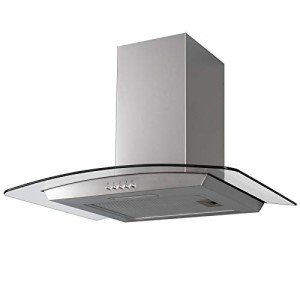Modern Extractor Fan
Add a review- Social Links:
Overview
-
Sectors Trường Dân lập - Tư thục
-
Posted Jobs 0
-
Viewed 60
Company Description
See What Hood Cooker Tricks The Celebs Are Utilizing
Everything You Need to Know About Hood Cookers: The Ultimate Kitchen Companion
Hood cookers, frequently referred to as range hoods, are important appliances in modern kitchens. They are created to ventilate the area by capturing heat, smoke, steam, and odors produced during cooking. With the diverse alternatives readily available, including different styles, mounting types, and functions, picking the ideal hood cooker can be a daunting task for numerous property owners. In this post, we will explore the world of hood cookers, exploring their types, functions, advantages, and crucial considerations for choosing the perfect range hood for your home.

Table of Contents
- Understanding Hood Cookers
- 1.1 What is a Hood Cooker?
- 1.2 Why Install a Hood Cooker?
- Kinds Of Hood Cookers
- 2.1 Wall-Mounted Range Hoods
- 2.2 Under-Cabinet Range Hoods
- 2.3 Island Range Hoods
- 2.4 Downdraft Ventilation
- Key Features to Consider
- 3.1 Size and Height
- 3.2 Airflow Efficiency
- 3.3 Noise Levels
- 3.4 Lighting Options
- 3.5 Filtration Systems
- Benefits of Having a Hood Cooker
- Tips for Choosing the Right Hood Cooker
- Often Asked Questions (FAQs)
1. Understanding Hood Cookers
1.1 What is a Hood Cooker?
A hood cooker is a kitchen home appliance created to remove air-borne grease, smoke, and smells produced while cooking. By effectively flowing air, hood cookers assist maintain a fresh and enjoyable environment in the kitchen.
1.2 Why Install a Hood Cooker?
Installing a hood cooker has numerous benefits:
- Improved Air Quality: It helps in removing humidity and impurities from the air.
- Enhanced Cooking Experience: A clean air environment makes cooking more satisfying.
- Safety: Reducing air-borne grease lessens the danger of kitchen fires.
- Visual Appeal: A trendy hood cooker can improve the overall style of a kitchen.
2. Types of Hood Cookers
Various types of hood cookers are readily available, each created to fit different kitchen designs and setups.
2.1 Wall-Mounted Range Hoods
Generally mounted above the cooking range on a wall, these hoods can be discovered in different designs, from conventional to modern.
Pros:
- Suitable for various kitchen styles.
- High suction power.
Cons:
- Requires adequate wall area.
2.2 Under-Cabinet Range Hoods
These are set up underneath kitchen cabinets, saving area while offering excellent ventilation.
Pros:
- Compact and space-saving.
- Easier to set up.
Cons:
- May not be as powerful as wall-mounted alternatives.
2.3 Island Range Hoods
These range hoods are developed for kitchens with a cooking island, hanging above the stovetop.
Pros:
- Aesthetic centerpiece.
- Supplies outstanding ventilation.
Cons:
- Higher installation expenses.
2.4 Downdraft Ventilation
Set up straight behind the cooktop, downdraft systems pull smoke and vapors down while cooking.
Pros:
- Discreet and minimalistic.
- Saves overhead area.
Cons:
- Less efficient for heavy cooking.
| Kind Of Hood Cooker | Pros | Cons |
|---|---|---|
| Wall-Mounted | Versatile, High suction power | Requires wall area |
| Under-Cabinet | Space-saving, Easy installation | Might have lower power |
| Island | Appealing, Excellent ventilation | Higher installation costs |
| Downdraft | Minimalist, Space-saving | Less efficient for heavy cooking |
3. Secret Features to Consider
When picking a hood cooker, keep these vital features in mind:
3.1 Size and Height
Select a hood cooker that matches the width of your cooktop. Typically, it should be at least 3 inches broader than the range on each side. The suggested height is 24 to 30 inches above the cooktop for wall-mounted hoods.
3.2 Airflow Efficiency
Measured in cubic feet per minute (CFM), air flow performance identifies how well the hood eliminates smoke and smells. A higher CFM ranking indicates better efficiency. Generally, a range hood ought to have a CFM rating of 300 to 600.
3.3 Noise Levels
Noise can be an essential consideration. Many range hoods run between 1.5 to 6.5 sones. A sones rating of 1.5 to 3.0 is thought about peaceful, while anything above that might be disruptive.
3.4 Lighting Options
Great lighting is important while cooking. Many hood cookers come geared up with incorporated lighting, which can be halogen, LED, or incandescent. Select bright lighting that can brighten your cooking surface effectively.
3.5 Filtration Systems
2 primary kinds of purification systems exist: ducted and ductless. Ducted hoods expel air exterior, while ductless hoods use filters to recirculate air. Select based on your kitchen’s design and choice.
| Function | Importance |
|---|---|
| Size and Height | Matches cooking surface area, makes sure performance |
| Air Flow Efficiency (CFM) | Determines the hood’s ability to aerate |
| Noise Levels | Convenience level throughout operation |
| Lighting Options | Exposure while cooking |
| Purification Systems | Ducted vs. ductless based on installation needs |
4. Advantages of Having a Hood Cooker
- Air Quality Improvement: Removes impurities in the air.
- Visually Pleasing: Enhances kitchen design.
- Increased Home Value: A well-designed range hood can increase resale worth.
- Cooking Safety: Reduces fire hazards by controlling grease build-up.
5. Tips for Choosing the Right Hood Cooker
- Evaluate Your Cooking Habits: Consider how frequently and intensively you prepare.
- Step Your Space: Ensure appropriate fit within your kitchen layout.
- Style Preferences: Choose a design that complements your kitchen design.
- Spending plan: Set a sensible spending plan that includes setup costs.
6. Regularly Asked Questions (FAQs)
Q1: Do I require a hood cooker if I have a gas stove?A1: Yes, it is recommended as gas stoves produce more pollutants and need correct ventilation for security and air quality. Q2: How typically should I clean up the hood filters?A2: It is suggested totidy grease filters every month and change charcoal filters
every 6 months to preserve effectiveness. Q3: Can I install a hood cooker myself?A3: While some people can install it, it is suggested to
work with an expert for appropriate installation
and positioning. Q4: What CFM rating is best for my kitchen?A4: A basic guideline is to intend for 100 CFM for every single 10,000 BTUs of your stove’s
output. For average home cooking, a CFM in between 300-600 ought to be enough. In conclusion, hood cookers are a crucial part of every modern kitchen, improving air quality, improving safety, and adding to the kitchen’s overall looks. By understanding the different types, features, and advantages, house owners can make informed choices that best suit their cooking habits and kitchen styles.
